The Influence of Indirect Bonding Technique on Adhesion of Orthodontic Brackets and Post-Debonding Enamel Integrity—An In Vitro Study
Abstract
:1. Introduction
2. Materials and Methods
2.1. Sample Preparation
2.2. Preparation of Transfer Trays
2.3. Adhesive Preparation and Bracket Placement
2.4. SEM of the Bracket–Enamel Interface
2.5. Shear Bond Strength
2.6. ARI Score
2.7. SEM-EDS of Specimens after SBS
2.8. Statistical Analysis
3. Results
3.1. SEM of the Bracket–Enamel Interface
3.2. Shear Bond Strength
3.3. ARI Score
3.4. SEM EDS Specimens after SBS
4. Discussion
5. Conclusions
- The type of bracket (metal/ceramic) has a significant effect on the SBS in the indirect bonding technique.
- Ceramic-OPC brackets bonded indirectly to the enamel surface achieved the highest SBS; hence, the enamel damage was significantly higher than that of other brackets.
- Metal-APC brackets bonded indirectly may represent the most appropriate choice due to the relatively high bond SBS and favourable debonding pattern.
- Ceramic brackets can be an alternative for metal brackets in cases that require a high bond strength.
- In the present study, the mean ARI score in all the tested groups did not exceed 2, which is a compromise between having a strong adhesive connection to the enamel (more resistant to applied orthodontic forces during treatment) and reduced time required for enamel polishing.
- The debonding of orthodontic brackets with high SBS values can lead to enamel damage even when it is not noticeable clinically.
- There is a need for the standardization of perimeters in in vitro orthodontic research.
Author Contributions
Funding
Institutional Review Board Statement
Informed Consent Statement
Data Availability Statement
Conflicts of Interest
Appendix A
| Group | Difference | SE | p-Value |
|---|---|---|---|
| Metal-OPC vs. Metal-APC | 3.542 | 0.5352 | 0.0002 |
| Metal-OPC vs. Ceramic-OPC | 4.819 | 0.5352 | 0.0000 |
| Metal-APC vs. Ceramic-OPC | 1.277 | 0.5352 | 0.2249 |
References
- Nawrocka, A.; Lukomska-Szymanska, M. The Indirect Bonding Technique in Orthodontics—A Narrative Literature Review. Materials 2020, 13, 986. [Google Scholar] [CrossRef]
- Pamukcu, H.; Ozsoy, O.P. Indirect Bonding Revisited. Turkish J. Orthod. 2017, 29, 80–86. [Google Scholar] [CrossRef] [PubMed]
- Sabbagh, H.; Khazaei, Y.; Baumert, U.; Hoffmann, L.; Wichelhaus, A.; Rankovic, M.J. Bracket Transfer Accuracy with the Indirect Bonding Technique—A Systematic Review and Meta-Analysis. J. Clin. Med. 2022, 11, 2568. [Google Scholar] [CrossRef] [PubMed]
- Ash, S.; Hay, N. Adhesive Pre-Coated Brackets, a Comparative Clinical Study. Br. J. Orthod. 1996, 23, 325–329. [Google Scholar] [CrossRef]
- Vorachart, W.; Sombuntham, N.; Parakonthun, K. Adhesive Precoated Bracket: Is It Worth Using? Long-Term Shear Bond Strength: An In Vitro Study. Eur. J. Dent. 2022, 16, 841–847. [Google Scholar] [CrossRef]
- Atik, E.; Gorucu-Coskuner, H.; Taner, T. Clinical Performance of Precoated Brackets and Self-Etch Bonding Technique: A Prospective Comparative Study. Clin. Oral Investig. 2019, 23, 2813–2821. [Google Scholar] [CrossRef] [PubMed]
- Ozer, M.; Bayram, M.; Dincyurek, C.; Tokalak, F. Clinical Bond Failure Rates of Adhesive Precoated Self-Ligating Brackets Using a Self-Etching Primer. Angle Orthod. 2014, 84, 155–160. [Google Scholar] [CrossRef]
- González-Serrano, C.; Baena, E.; Fuentes, M.V.; Albaladejo, A.; Míguez-Contreras, M.; Lagravère, M.O.; Ceballos, L. Shear Bond Strength of a Flash-Free Orthodontic Adhesive System after Thermal Aging Procedure. J. Clin. Exp. Dent. 2019, 11, e154–e161. [Google Scholar] [CrossRef]
- Vicente, A.; Bravo, L.A. Shear Bond Strength of Precoated and Uncoated Brackets Using a Self-Etching Primer: An in Vitro Study. Angle Orthod. 2007, 77, 524–527. [Google Scholar] [CrossRef]
- Namura, Y.; Takamizawa, T.; Uchida, Y.; Inaba, M.; Noma, D.; Takemoto, T.; Miyazaki, M.; Motoyoshi, M. Effects of Composition on the Hardness of Orthodontic Adhesives. J. Oral Sci. 2020, 62, 48–51. [Google Scholar] [CrossRef]
- Tümoğlu, M.; Akkurt, A. Comparison of Clinical Bond Failure Rates and Bonding Times between Two Adhesive Precoated Bracket Systems. Am. J. Orthod. Dentofac. Orthop. 2019, 155, 523–528. [Google Scholar] [CrossRef] [PubMed]
- El Sherifa, M.T.; Shamaa, M.S.; Montasser, M.A. Enamel around Orthodontic Brackets Coated with Flash-Free and Conventional Adhesives. J. Orofac. Orthop. 2020, 81, 419–426. [Google Scholar] [CrossRef] [PubMed]
- Kieling, T.C.B.; Correr-Sobrinho, L.; Godoi, A.P.T.D.; Menezes, C.C.D.; Venezian, G.C.; Costa, A.R. Fracture strength of monocrystalline and polycrystalline ceramic brackets during archwire torque. Rev. Odontol. UNESP 2019, 48, e20190048. [Google Scholar] [CrossRef]
- Elekdag-Türk, S.; Yilmaz, H. Ceramic Brackets Revisited. In Current Approaches in Orthodontics; IntechOpen: London, UK, 2019. [Google Scholar]
- Chu, C.H.; Ou, K.L.; Dong, D.R.; Huang, H.M.; Tsai, H.H.; Wang, W.N. Orthodontic Bonding with Self-Etching Primer and Self-Adhesive Systems. Eur. J. Orthod. 2011, 33, 276–281. [Google Scholar] [CrossRef] [PubMed]
- Yamada, R.; Hayakawa, T.; Kasai, K. Effect of Using Self-Etching Primer for Bonding Orthodontic Brackets. Angle Orthod. 2002, 72, 558–564. [Google Scholar] [PubMed]
- Lamper, T.; Ilie, N.; Huth, K.C. Self-Etch Adhesives for the Bonding of Orthodontic Brackets: Faster, Stronger, Safer? Clin. Oral Investig. 2014, 18, 313–319. [Google Scholar] [CrossRef]
- Bayar Bilen, H.; Çokakoğlu, S. Effects of One-Step Orthodontic Adhesive on Microleakage and Bracket Bond Strength: An in Vitro Comparative Study. Int. Orthod. 2020, 18, 366–373. [Google Scholar] [CrossRef]
- Nawrocka, A.; Łukomska-Szymańska, M. Extracted Human Teeth and Their Utility in Dental Research. Recommendations on Proper Preservation: A Literature Review. Dent. Med. Probl. 2019, 56, 185–190. [Google Scholar] [CrossRef]
- Sondhi, A. Effective and Efficient Indirect Bonding: The Sondhi Method. Semin. Orthod. 2007, 13, 43–57. [Google Scholar] [CrossRef]
- Muguruma, T.; Yasuda, Y.; Iijima, M.; Kohda, N.; Mizoguchi, I. Force and amount of resin composite paste used in direct and indirect bonding. Angle Orthod. 2010, 80, 1089–1094. [Google Scholar] [CrossRef]
- Gibas-Stanek, M.; Williams, S.; Ryniewicz, W.I.; Loster, B.W. Variations in orthodontic bracket retention related to base design. Comparison of foil mesh and anchor pylons brackets. J. Stomatol. 2016, 70, 680–694. [Google Scholar] [CrossRef]
- Demirovic, K.; Slaj, M.; Spalj, S.; Slaj, M.; Kobaslija, S. Comparison of Shear Bond Strength of Orthodontic Brackets Using Direct and Indirect Bonding Methods in Vitro and in Vivo. Acta Inform. Medica 2018, 26, 125–129. [Google Scholar] [CrossRef]
- Årtun, J.; Bergland, S. Clinical Trials with Crystal Growth Conditioning as an Alternative to Acid-Etch Enamel Pretreatment. Am. J. Orthod. 1984, 85, 333–340. [Google Scholar] [CrossRef]
- Cochrane, N.J.; Lo, T.W.G.; Adams, G.G.; Schneider, P.M. Quantitative Analysis of Enamel on Debonded Orthodontic Brackets. Am. J. Orthod. Dentofac. Orthop. 2017, 152, 312–319. [Google Scholar] [CrossRef] [PubMed]
- Nawrocka, A.; Piwonski, I.; Sauro, S.; Porcelli, A.; Hardan, L.; Lukomska-Szymanska, M. Traditional Microscopic Techniques Employed in Dental Adhesion Research-Applications and Protocols of Specimen Preparation. Biosensors 2021, 11, 408. [Google Scholar] [CrossRef]
- Guzman, U.A.; Jerrold, L.; Vig, P.S.; Abdelkarim, A. Comparison of Shear Bond Strength and Adhesive Remnant Index between Precoated and Conventionally Bonded Orthodontic Brackets. Prog. Orthod. 2013, 14, 39. [Google Scholar] [CrossRef]
- Abdelaziz, K.M.; Alshahrani, I.; Kamran, M.A.; Alnazeh, A. Debonding characteristics of orthodontic brackets subjected to intraoral stresses under different adhesive regimes: An in-vitro study. J. Appl. Biomater. Funct. Mater. 2020, 18, 2280800019899640. [Google Scholar] [CrossRef]
- Marc, M.-G.; Bazert, C.; Attal, J.-P. Bond Strength of Pre-Coated Flash-Free Adhesive Ceramic Brackets. An in Vitro Comparative Study on the Second Mandibular Premolars. Int. Orthod. 2018, 16, 425–439. [Google Scholar] [CrossRef] [PubMed]
- Ansari, M.Y.; Agarwal, D.K.; Gupta, A.; Bhattacharya, P.; Ansar, J.; Bhandari, R. Shear Bond Strength of Ceramic Brackets with Different Base Designs: Comparative in-Vitro Study. J. Clin. Diagn. Res. 2016, 10, ZC64–ZC68. [Google Scholar] [CrossRef]
- Lee, M.; Kanavakis, G. Comparison of Shear Bond Strength and Bonding Time of a Novel Flash-Free Bonding System. Angle Orthod. 2016, 86, 265–270. [Google Scholar] [CrossRef] [PubMed]
- Wang, D.; Hu, R.; Mabry, J.N.; Miao, B.; Wu, D.T.; Koynov, K.; Schwartz, D.K. Scaling of Polymer Dynamics at an Oil–Water Interface in Regimes Dominated by Viscous Drag and Desorption-Mediated Flights. J. Am. Chem. Soc. 2015, 137, 12312–12320. [Google Scholar] [CrossRef] [PubMed]
- Kawaguchi, D.; Nakayama, R.; Koga, H.; Totani, M.; Tanaka, K. Improvement of polymer adhesion by designing the interface layer. Polymer 2023, 265, 125581. [Google Scholar] [CrossRef]
- Wong, M.; Power, S. A Prospective Randomized Clinical Trial to Compare Pre-Coated and Non-Pre-Coated Brackets. J. Orthod. 2003, 30, 155–158. [Google Scholar] [CrossRef] [PubMed]
- Kula, K.; Schreiner, R.; Brown, J.; Glaros, A. Clinical Bond Failure of Pre-Coated and Operatorcoated Orthodontic Brackets. Orthod. Craniofac. Res. 2002, 5, 161–165. [Google Scholar] [CrossRef] [PubMed]
- Bishara, S.E.; Olsen, M.; Von Wald, L. Comparisons of Shear Bond Strength of Precoated and Uncoated Brackets. Am. J. Orthod. Dentofac. Orthop. 1997, 112, 617–621. [Google Scholar] [CrossRef]
- Khan, H.; Price, S. Orthodontic Brackets: Selection, Placement and Debonding; CreateSpace Independent Publishing Platform: Scotts Valley, CA, USA, 2015; ISBN 978-1508936275. [Google Scholar]
- Bishara, S.E.; Ajlouni, R.; Laffoon, J.; Warren, J. Effects of Modifying the Adhesive Composition on the Bond Strength of Orthodontic Brackets. Angle Orthod. 2002, 72, 464–467. [Google Scholar]
- Moecke, S.E.; Barros, P.C.A.; Andrade, A.C.M.; Borges, A.B.; Pucci, C.R.; Torres, C.R.G. Efficacy of Bracket Adhesive Remnant Removal by a Fluorescence-Aided Identification Technique with a UV Light Handpiece: In Vitro Study. Int. J. Dent. 2022, 2022, 4821021. [Google Scholar] [CrossRef]
- Mavreas, D.; Athanasiou, A.E. Factors Affecting the Duration of Orthodontic Treatment: A Systematic Review. Eur. J. Orthod. 2008, 30, 386–395. [Google Scholar] [CrossRef]
- Beckwith, F.R.; Ackerman, R.J.; Cobb, C.M.; Tira, D.E. An Evaluation of Factors Affecting Duration of Orthodontic Treatment. Am. J. Orthod. Dentofacial Orthop. 1999, 115, 439–447. [Google Scholar] [CrossRef]
- Kamak, H. Orthodontic brackets selection, placement and debonding. J. Orthod. Res. 2015, 3, 208. [Google Scholar]
- Eliades, T. Research Methods in Orthodontics; Springer: Cham, Switzerland, 2006; Volume 1999. [Google Scholar]
- Zou, L.; Zhou, Q. Quantitative analysis of carbon in carbon steel using SEM/EDS followed by error correction approach. Microsc. Microanal. 2013, 19, 1048–1049. [Google Scholar] [CrossRef]
- Lee, Y.K.; Lim, Y.K. Three-dimensional quantification of adhesive remnants on teeth after debonding. Am. J. Orthod. Dentofac. Orthop. 2008, 134, 556–562. [Google Scholar] [CrossRef]
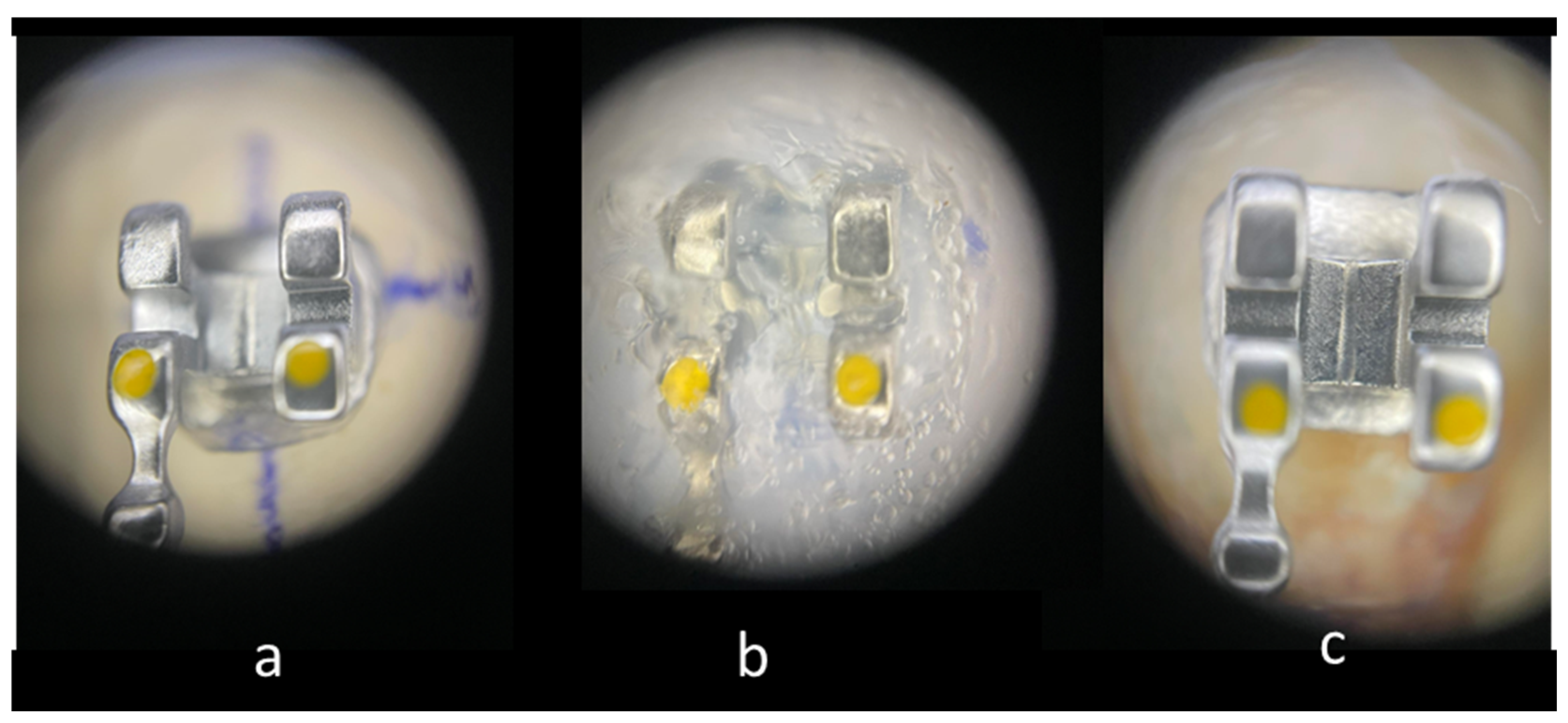
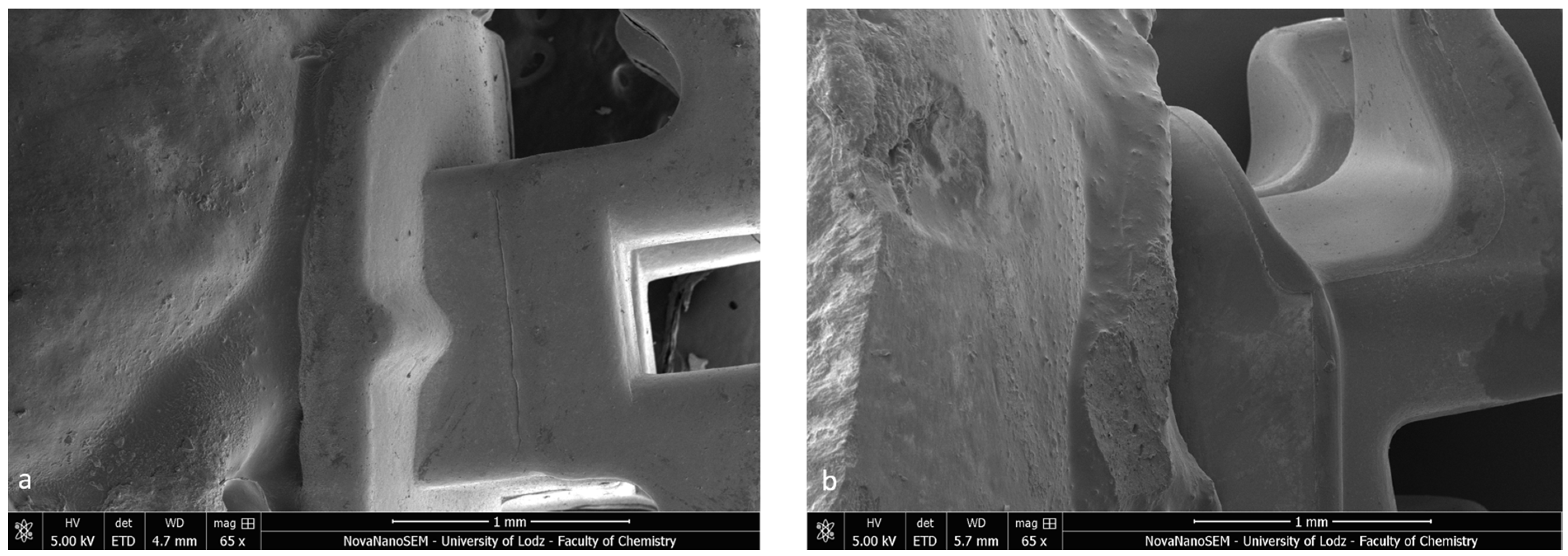
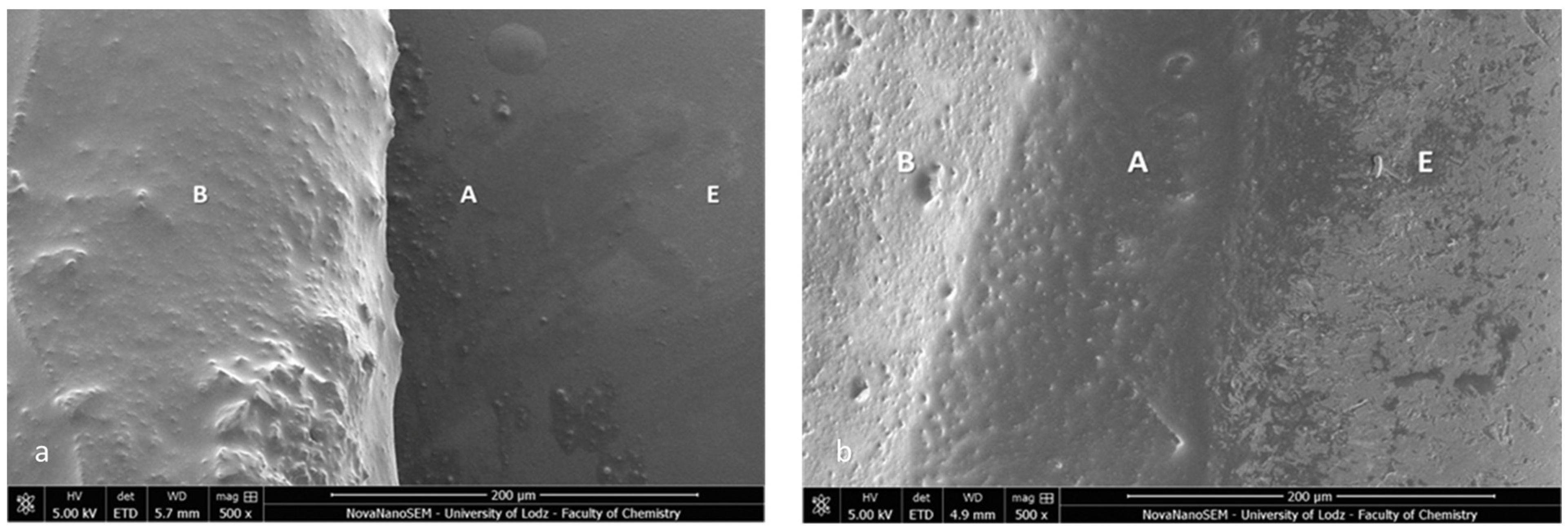

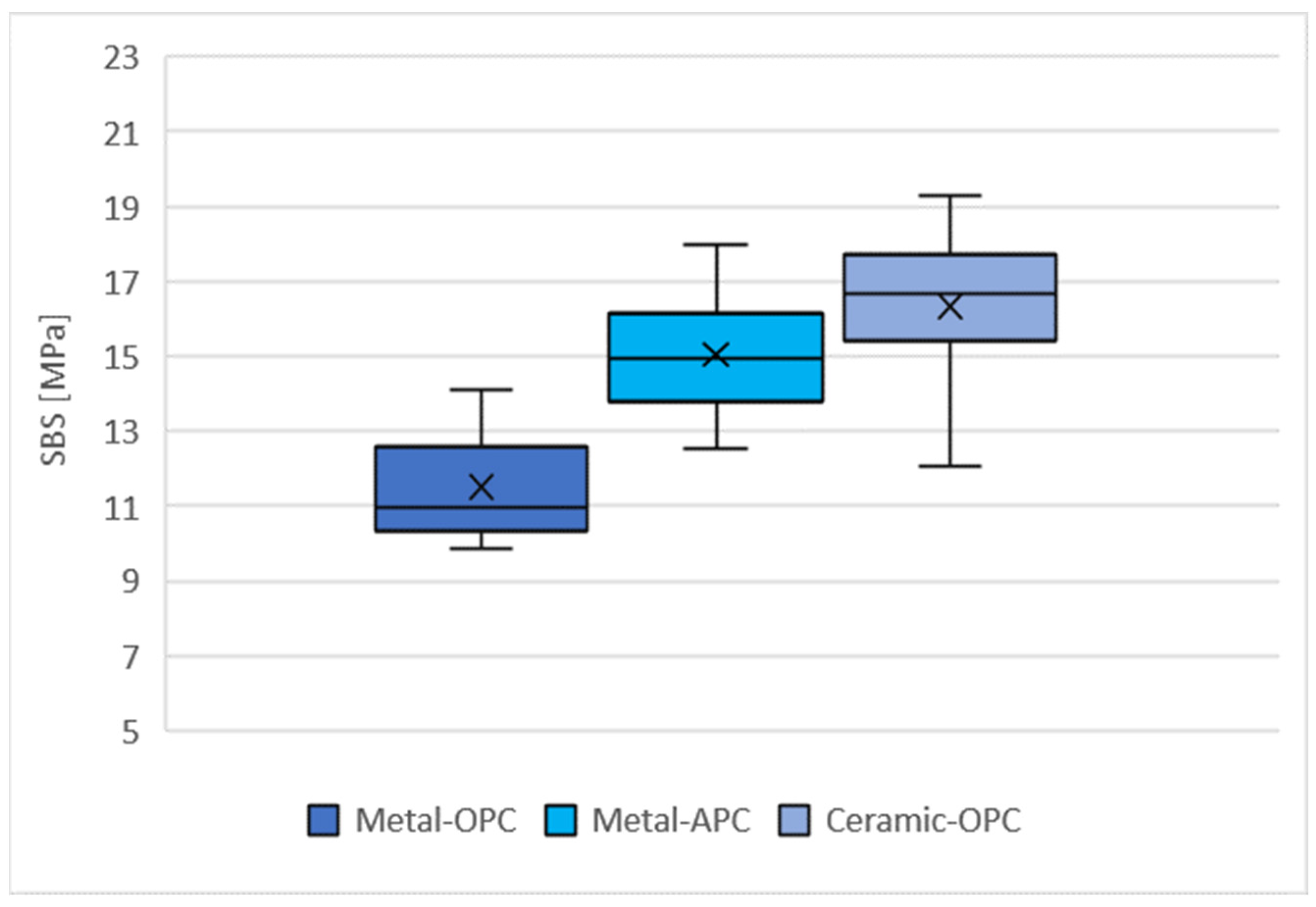

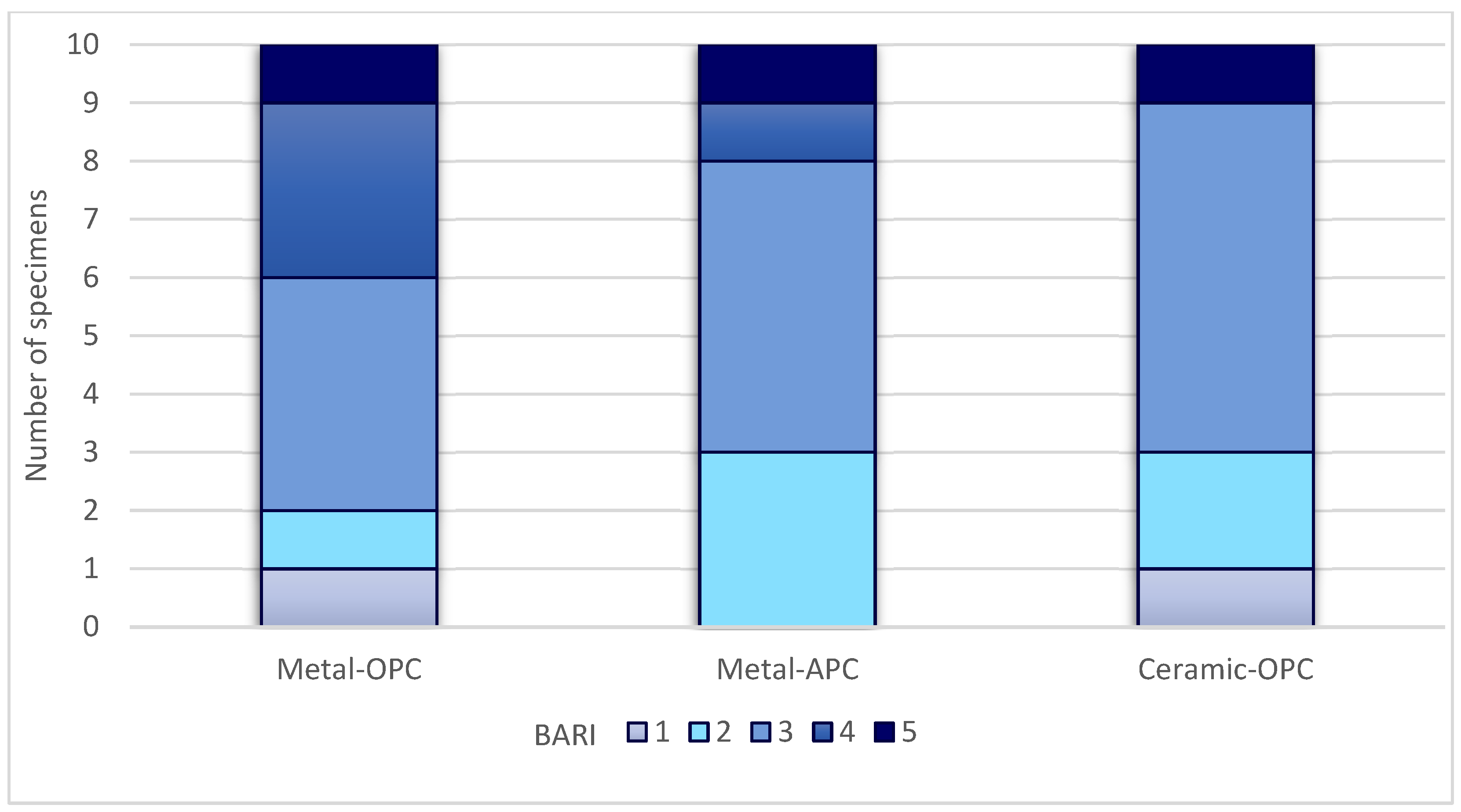
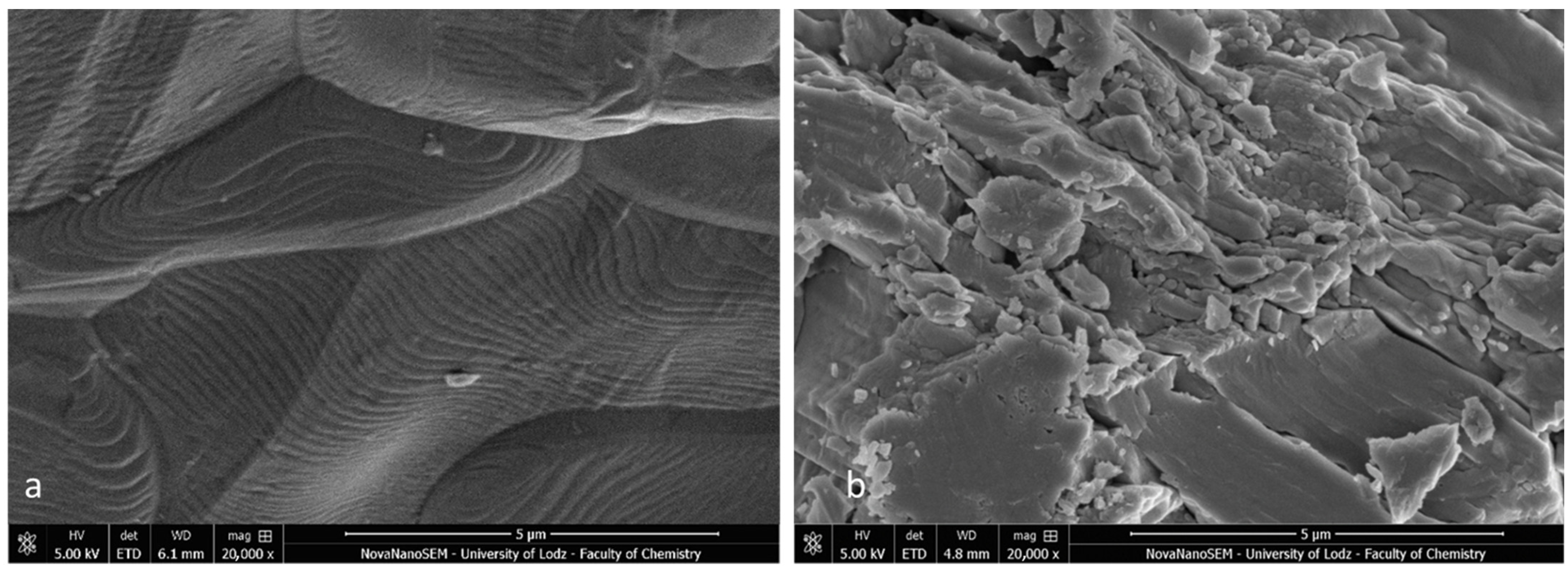
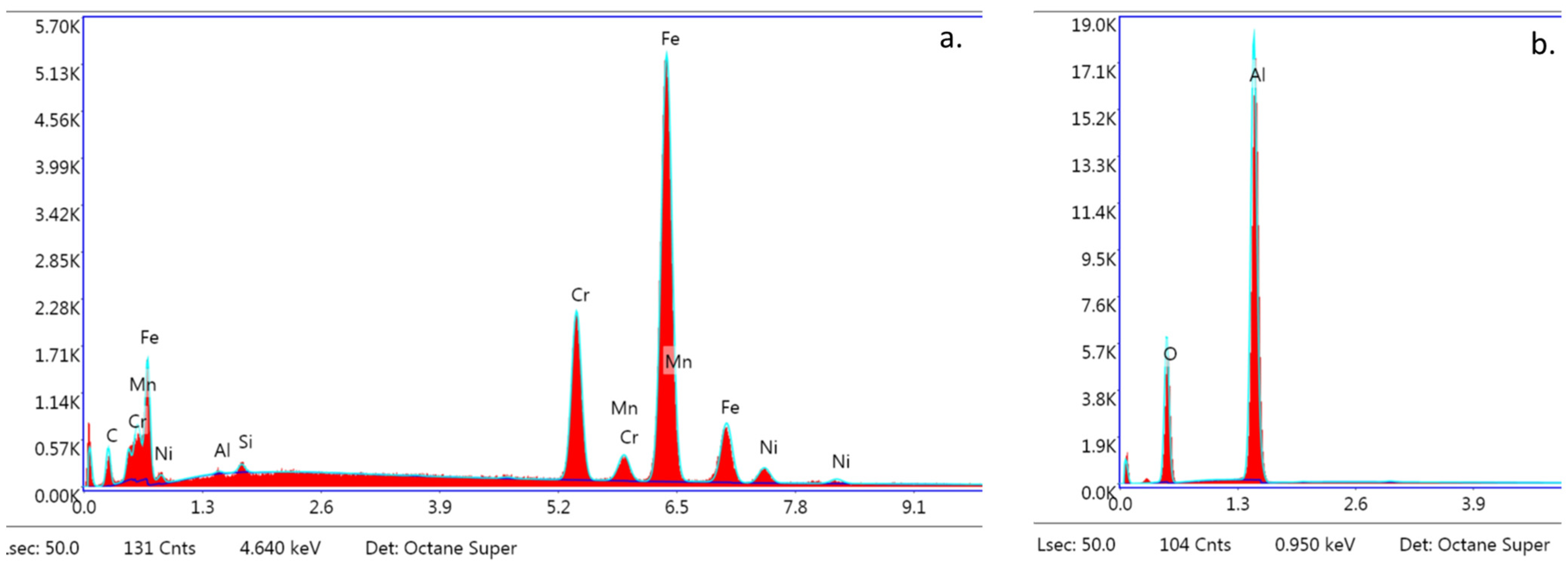


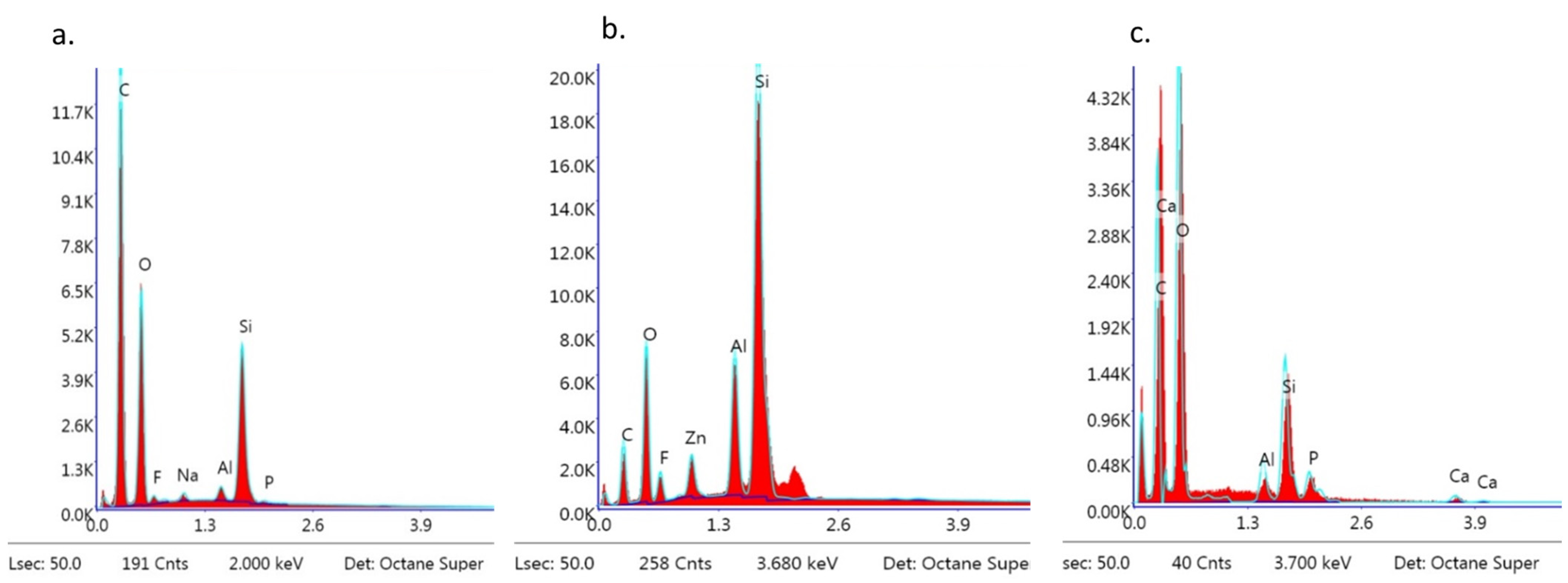
| Application Area | Procedure |
|---|---|
| Bracket | Application of Transbond XT Light Cure Adhesive * |
| Light curing (15 s) | |
| Cast | Bracket positioning |
| Preparation of transfer trays from Emiluma and Lumaloc and placing the cast into the water for 30 min | |
| Removal of transfer trays (with brackets inside) | |
| Enamel | Etching (30 s), rinsing (30 s), and drying (30 s) |
| Application of Sondhi Rapid Set System: | |
| Placing the tray | |
| Removal of the tray after material setting (2 min.) |
| Material | Type of Material | Composition | Application Time | Area of Application |
|---|---|---|---|---|
| Scotchbond Universal Etchant (3M ESPE, St. Paul, MN, USA) | Acid | 32% wg. H3PO4 | 30 s | Enamel (cleaned) |
| Transbond XT Primer (3M Unitek, Monrovia, CA, USA) | Polymerizable monomer | TEGDMA, Bis-GMA | NA | Enamel (etched, rinsed, dried) |
| Transbond XT (3M Unitek, Monrovia, CA, USA) | Light cure adhesive resin with quartz filler | Silane-treated quartz, Bis-GMA, silane; 77% quartz filler | NA | Bracket base |
| Sondhi Rapid Set Resin A (3M Unitek, Monrovia, CA, USA) | Chemical cure adhesive resin with silica filler | TEGDMA, Bis-GMA, silane treated silica, SbPh3, HQ | 3–5 s per tooth followed by a gentle air burst for 1–2 s | Enamel (etched, rinsed) |
| Sondhi Rapid Set Resin B (3M Unitek, Monrovia, CA, USA) | Chemical cure adhesive resin | TEGDMA, Bis-GMA, silane treated silica, SbPh3, HQ, PTDE, dimethyl siloxane | NA | Bracket base |
| Emiluma (Ultradent Products Inc., South Jordan, UT, USA) | Silicone | Vinyl polisiloxane | NA | Cast |
| Lumaloc (Ultradent Products Inc., South Jordan, UT, USA) | Silicone | Quartz, silicone dioxide, tridecyl alcohol ethoxylated, dimethylsiloxane | Placed in water for 30 min after application | Cast (on the Emiluma layer) |
| Study Group | Manufacturer | Bracket Type | Internal Structure | Prescription | Base Type | Base Area |
|---|---|---|---|---|---|---|
| Metal-OPC | Victory Series™ (3M, Unitek, Monrovia, CA, USA) | Metal | Austenitic stainless steel | .022″ MBT for upper premolar | Foil mesh | 8.97 mm2 |
| Metal-APC | APC Plus™ Victory Series™ (3M, Unitek, Monrovia, CA, USA) | Metal | Austenitic stainless steel | .022″ MBT for upper premolar | Foil mesh covered with light cure adhesive | 8.97 mm2 |
| Ceramic-OPC | Clarity™ Advanced (3M, Unitek, Monrovia, CA, USA) | Ceramic | Polycrystalline | .022″ MBT for upper premolar | Microcrystalline mechanical | 11.69 mm2 |
| Amount of Adhesive on Bracket Base [25] | BARI Score [25] | ARI Score [24] | Adhesive Left on the Tooth [24] |
|---|---|---|---|
| 0% | 1 | 3 | 100% (Distinct impression of the bracket mesh) |
| <25% | 2 | 2 | >50% |
| >25% and <50% | 3 | 2 | |
| >75% | 4 | 1 | <50% |
| 100% | 5 | 0 | 0% |
| Bracket Type | Element | Weight% | Atomic% |
|---|---|---|---|
| Metal OPC | C | 8.94 | 30.99 |
| Al | 0.13 | 0.20 | |
| Si | 0.35 | 0.52 | |
| Cr | 15.61 | 12.50 | |
| Mn | 1.16 | 0.88 | |
| Fe | 70.07 | 52.26 | |
| Ni | 3.74 | 2.65 | |
| Ceramic-OPC | O | 44.60 | 57.58 |
| Al. | 55.40 | 42.42 |
| Bracket Type | Element | Weight% | Atomic% |
|---|---|---|---|
| Metal-OPC | C | 58.88 | 66.94 |
| O | 34.96 | 29.84 | |
| F | 0.69 | 0.0 | |
| Na | 0.50 | 0.30 | |
| Al | 0.47 | 0.24 | |
| Si | 4.50 | 2.19 | |
| P | 0.00 | 0.00 | |
| Metal-APC | C | 28.00 | 41.23 |
| O | 27.83 | 30.76 | |
| F | 6.80 | 6.33 | |
| Al. | 7.09 | 4.64 | |
| Si | 21.97 | 13.83 | |
| P | 3.20 | 1.83 | |
| Zn | 5.12 | 1.38 | |
| Ceramic-OPC | C | 39.40 | 47.59 |
| O | 54.27 | 49.21 | |
| Al | 1.21 | 0.65 | |
| Si | 4.06 | 2.09 | |
| P | 0.67 | 0.32 | |
| Ca | 0.38 | 0.14 |
| Author | Number of Specimens | Type of Brackets | Conclusions |
|---|---|---|---|
| Guzman et al. (2013) [27] | 90 | Metal-OPC vs. Metal-APC | NSD |
| González-Serrano et al. (2019) [8] | 120 | Ceramic-OPC vs. Ceramic-APC | NSD |
| Marc et al. 2018 [29] | 45 | Ceramic-OPC vs. Ceramic-APC | NSD |
| Ansari et al. (2016) [30] | 50 | Ceramic-OPC vs. Ceramic-APC | SBS in APC significantly lower than in OPC |
| Lee et al. (2015) [31] | 36 | Ceramic-OPC vs. Ceramic-APC | SBS in APC significantly higher than in OPC |
| Abdelaziz (2020) [28] | 96 | Metal-OPC vs. Metal-APC | NSD between APC and OPC, SBS in ER significantly higher than in SE |
| Author (Year) | Type of Brackets | Mean mARI Converted to Artun’s Index | Interpretation | Author’s Conclusion |
|---|---|---|---|---|
| Lee et al. (2015) [31] | Ceramic APC Plus | 2.66 | >50% of adhesive left on the tooth in 100% APC specimens | NSD in ARI of APC Plus and OPC |
| Ceramic OPC | 2.58 | |||
| Ansari et al. (2016) [30] | Ceramic APC Flash Free | 2.3 | >50% of adhesive left on the tooth in 80% APC specimens | Both brackets achieved safe bracket failure pattern |
| Ceramic OPC | 2.8 | |||
| González-Serrano et al. (2019) [8] | Ceramic APC Flash Free | 0.85 * without thermocycling | <50% of adhesive left on the tooth in 100% APC specimens | APC left significantly lower amount of adhesive on the tooth surface after debonding |
| Ceramic OPC | 1.75 * without thermocycling | |||
| Abdelaziz (2020) [28] | Metal APC Plus, E&R | 0.58 | <50% adhesive left on the tooth in 80% APC specimens | NSD in ARI of APC and OPC |
| Metal OPC, E&R | 0.79 | |||
| Guzman et al. (2013) [27] | Metal ACP | 1.47 | <50% adhesive left on the tooth in 50% APC specimens | APC left significantly lower amount of adhesive than OPC |
| Metal OPC | 1.97 |
Disclaimer/Publisher’s Note: The statements, opinions and data contained in all publications are solely those of the individual author(s) and contributor(s) and not of MDPI and/or the editor(s). MDPI and/or the editor(s) disclaim responsibility for any injury to people or property resulting from any ideas, methods, instructions or products referred to in the content. |
© 2023 by the authors. Licensee MDPI, Basel, Switzerland. This article is an open access article distributed under the terms and conditions of the Creative Commons Attribution (CC BY) license (https://creativecommons.org/licenses/by/4.0/).
Share and Cite
Nawrocka, A.; Piwonski, I.; Nowak, J.; Sauro, S.; García-Esparza, M.A.; Hardan, L.; Lukomska-Szymanska, M. The Influence of Indirect Bonding Technique on Adhesion of Orthodontic Brackets and Post-Debonding Enamel Integrity—An In Vitro Study. Materials 2023, 16, 7202. https://doi.org/10.3390/ma16227202
Nawrocka A, Piwonski I, Nowak J, Sauro S, García-Esparza MA, Hardan L, Lukomska-Szymanska M. The Influence of Indirect Bonding Technique on Adhesion of Orthodontic Brackets and Post-Debonding Enamel Integrity—An In Vitro Study. Materials. 2023; 16(22):7202. https://doi.org/10.3390/ma16227202
Chicago/Turabian StyleNawrocka, Agnieszka, Ireneusz Piwonski, Joanna Nowak, Salvatore Sauro, María Angeles García-Esparza, Louis Hardan, and Monika Lukomska-Szymanska. 2023. "The Influence of Indirect Bonding Technique on Adhesion of Orthodontic Brackets and Post-Debonding Enamel Integrity—An In Vitro Study" Materials 16, no. 22: 7202. https://doi.org/10.3390/ma16227202
APA StyleNawrocka, A., Piwonski, I., Nowak, J., Sauro, S., García-Esparza, M. A., Hardan, L., & Lukomska-Szymanska, M. (2023). The Influence of Indirect Bonding Technique on Adhesion of Orthodontic Brackets and Post-Debonding Enamel Integrity—An In Vitro Study. Materials, 16(22), 7202. https://doi.org/10.3390/ma16227202










